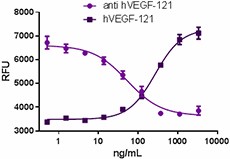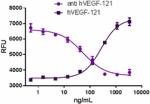- Clone
- A15136B (See other available formats)
- Regulatory Status
- RUO
- Other Names
- VEGFA, MVCD1, VEGF, Vascular permeability factor (VPF)
- Isotype
- Mouse IgG2b, κ
- Ave. Rating
- Submit a Review
- Product Citations
- publications

-

Recombinant human VEGF-121 stimulates proliferation of HUVEC in a dose-dependent manner (dark purple squares). Proliferation induced by recombinant human VEGF-121 (15 ng/mL) is neutralized (purple circles) by increasing concentrations of anti-VEGF-121 (clone A15136B) antibody. The ND50 is typically 25 - 100 ng/mL.
| Cat # | Size | Price | Quantity Check Availability | Save | ||
|---|---|---|---|---|---|---|
| 692203 | 100 µg | 270 CHF | ||||
| 692204 | 1 mg | 715 CHF | ||||
VEGF was initially identified in conditioned medium from bovine pituitary follicular cells. VEGF-A belongs to the VEGF family, which has the following members: VEGF-A, VEGF-B, VEGF-C, VEGF-D, and PlGF (placental growth factor). In addition, viral VEGF homologs (collectively called VEGF-E) and snake venom VEGFs such as T.f. (Trimeresurus flavoviridis) and svVEGF (called VEGF-F) have been described. VEGFA is alternatively spliced to generate variants with different number of amino acids such as VEGF-121, VEGF-145, VEGF-165, and VEGF-189. While VEGF-121 is freely diffusible and does not bind to heparin sulphate, VEGF-165 and VEGF-189 bind to heparin sulfate, resulting in retention on the cell surface or in the extracellular matrix. VEGF-A is highly expressed in solid tumors generated in breast, lung, renal, colorectal and liver tissues. VEGF has strong vascular permeability activity and significantly contributes to the formation of ascites tumors. VEGF can act as a direct proinflammatory mediator during the pathogenesis of rheumatoid arthritis (RA) and protect rheumatoid synoviocytes from apoptosis, which contributes to synovial hyperplasia. VEGF is expressed in synovial macrophages and synovial fibroblasts in RA patients. Also, VEGF is associated with age-related macular degeneration (AMD). AMD is due to neovascularization that originates from endothelial cells in the choroid that grow into neurosensory retina as choroidal neovascularization (CNV).
Product DetailsProduct Details
- Verified Reactivity
- Human
- Antibody Type
- Monoclonal
- Host Species
- Mouse
- Immunogen
- Recombinant human VEGF-121.
- Formulation
- Phosphate-buffered solution, pH 7.2, containing no preservative.
- Endotoxin Level
- Less than 0.01 EU/µg of the protein (< 0.001 ng/µg of the protein) as determined by the LAL test.
- Preparation
- The Ultra-LEAF™ (Low Endotoxin, Azide-Free) antibody was purified by affinity chromatography.
- Concentration
- The antibody is bottled at the concentration indicated on the vial, typically between 2 mg/mL and 3 mg/mL. Older lots may have also been bottled at 1 mg/mL. To obtain lot-specific concentration and expiration, please enter the lot number in our Certificate of Analysis online tool.
- Storage & Handling
- The antibody solution should be stored undiluted between 2°C and 8°C. This Ultra-LEAF™ solution contains no preservative; handle under aseptic conditions.
- Application
-
Neut - Quality tested
- Recommended Usage
-
Each lot of this antibody is quality control tested by neutralization. The ND50 is 25 - 100 ng/mL. It is recommended that the reagent be titrated for optimal performance for each application.
- RRID
-
AB_2632761 (BioLegend Cat. No. 692203)
AB_2632762 (BioLegend Cat. No. 692204)
Antigen Details
- Structure
- Homodimer.
- Function
- VEGFA is a key player in vasculogenesis, the formation of blood vessels from progenitor cells, as well as angiogenesis. The expression of the VEGFA gene is upregulated via hypoxia, estrogen, and NF-κB pathways. In addition VEGF is upregulated by PDGF-BB, P1GF, TGFβ1, IGF1, FGFs, HGF, TNFα, and IL-1. VEGFA induces proliferation and cell migration in endothelial cells and plays important roles during wound healing. Also, VEGF regulates hematopoietic stem cell survival.
- Interaction
- VEGFA interacts with vascular endothelial cells and monocytes/macrophages, which express VEGFR1. This interaction induces proliferation of endothelial cells and stimulates migration of monocytes/macrophages.
- Ligand/Receptor
- VEGFR1 (Flt-1) and VEGFR2 (KDR/Flk-1).
- Biology Area
- Angiogenesis, Cancer Biomarkers, Cell Biology, Cell Proliferation and Viability
- Molecular Family
- Cytokines/Chemokines
- Antigen References
-
1. Conn G, et al. 1990. Proc. Natl. Acad. Sci. USA 87:1323.
2. Gerber H, et al. 2002. Nature 417:954.
3. Shibuya M, et al. 2006. J. Biochem. Mol. Biol. 39:469.
4. Shibuya M, et al. 2008. BMB Rep. 41:278.
5. Monaghan-Benson E, et al. 2010. The American Journal of Pathology 177:2091.
6. Koch S, Claesson-Welsh L. 2012. Cold Spring Harb. Perspect. Med. 2:a006502. - Gene ID
- 7422 View all products for this Gene ID
- UniProt
- View information about VEGF-121 on UniProt.org
Related Pages & Pathways
Pages
Related FAQs
- Do you guarantee that your antibodies are totally pathogen free?
-
BioLegend does not test for pathogens in-house aside from the GoInVivo™ product line. However, upon request, this can be tested on a custom basis with an outside, independent laboratory.
- Does BioLegend test each Ultra-LEAF™ antibody by functional assay?
-
No, BioLegend does not test Ultra-LEAF™ antibodies by functional assays unless otherwise indicated. Due to the possible complexities and variations of uses of biofunctional antibodies in different assays and because of the large product portfolio, BioLegend does not currently perform functional assays as a routine QC for the antibodies. However, we do provide references in which the antibodies were used for functional assays and we do perform QC to verify the specificity and quality of the antibody based on our strict specification criteria.
- Does BioLegend test each Ultra-LEAF™ antibody for potential pathogens?
-
No, BioLegend does not test for pathogens in-house unless otherwise indicated. However, we can recommend an outside vendor to perform this testing as needed.
- Have you tested this Ultra-LEAF™ antibody for in vivo or in vitro applications?
-
We don't test our antibodies for in vivo or in vitro applications unless otherwise indicated. Depending on the product, the TDS may describe literature supporting usage of a particular product for bioassay. It may be best to further consult the literature to find clone specific information.
Other Formats
View All VEGF-121 Reagents Request Custom Conjugation| Description | Clone | Applications |
|---|---|---|
| Ultra-LEAF™ Purified anti-VEGF-121 | A15136B | Neut |
Compare Data Across All Formats
This data display is provided for general comparisons between formats.
Your actual data may vary due to variations in samples, target cells, instruments and their settings, staining conditions, and other factors.
If you need assistance with selecting the best format contact our expert technical support team.
-
Ultra-LEAF™ Purified anti-VEGF-121

Recombinant human VEGF-121 stimulates proliferation of HUVEC...
 Login / Register
Login / Register 








Follow Us